Ảnh hưởng của sự đồng cảm, hành vi hướng đến khách hàng của nhân viên giao dịch đến sự hài lòng của khách hàng
Phân tích các tiền tố ảnh hưởng đến sự hài lòng của khách
hàng là một chủ đề hấp dẫn. Bài viết được thực hiện với mục tiêu
xác định ảnh hưởng của sự đồng cảm, hành vi hướng đến khách
hàng của nhân viên đến sự hài lòng của khách hàng với nhân viên
giao dịch ở thị trường giao dịch chứng khoán tại Thành phố Hồ Chí
Minh. Mô hình phương trình cấu trúc bình phương tối thiểu từng
phần (PLS – SEM) được sử dụng để kiểm định các giả thuyết, bằng
việc sử dụng dữ liệu khảo sát của 211 cặp nhân viên giao dịch –
khách hàng. Kết quả phân tích cho thấy các tiền tố có ảnh hưởng
tích cực đến sự hài lòng của khách hàng. Kết quả nghiên cứu có giá
trị lý thuyết lẫn thực tiễn. Về mặt lý thuyết, kết quả nghiên cứu
củng cố lý thuyết trao đổi xã hội. Về mặt thực tiễn, các nhà quản lý
cần tuyển chọn những ứng viên có sự đồng cảm cho các vị trí có sự
tiếp xúc nhiều với khách hàng để góp phần gia tăng sự hài lòng của
khách hàng trong quá trình giao dịch. Ngoài ra, các hoạt động tập
huấn cũng giúp nâng cao sự đồng cảm của nhân viên.
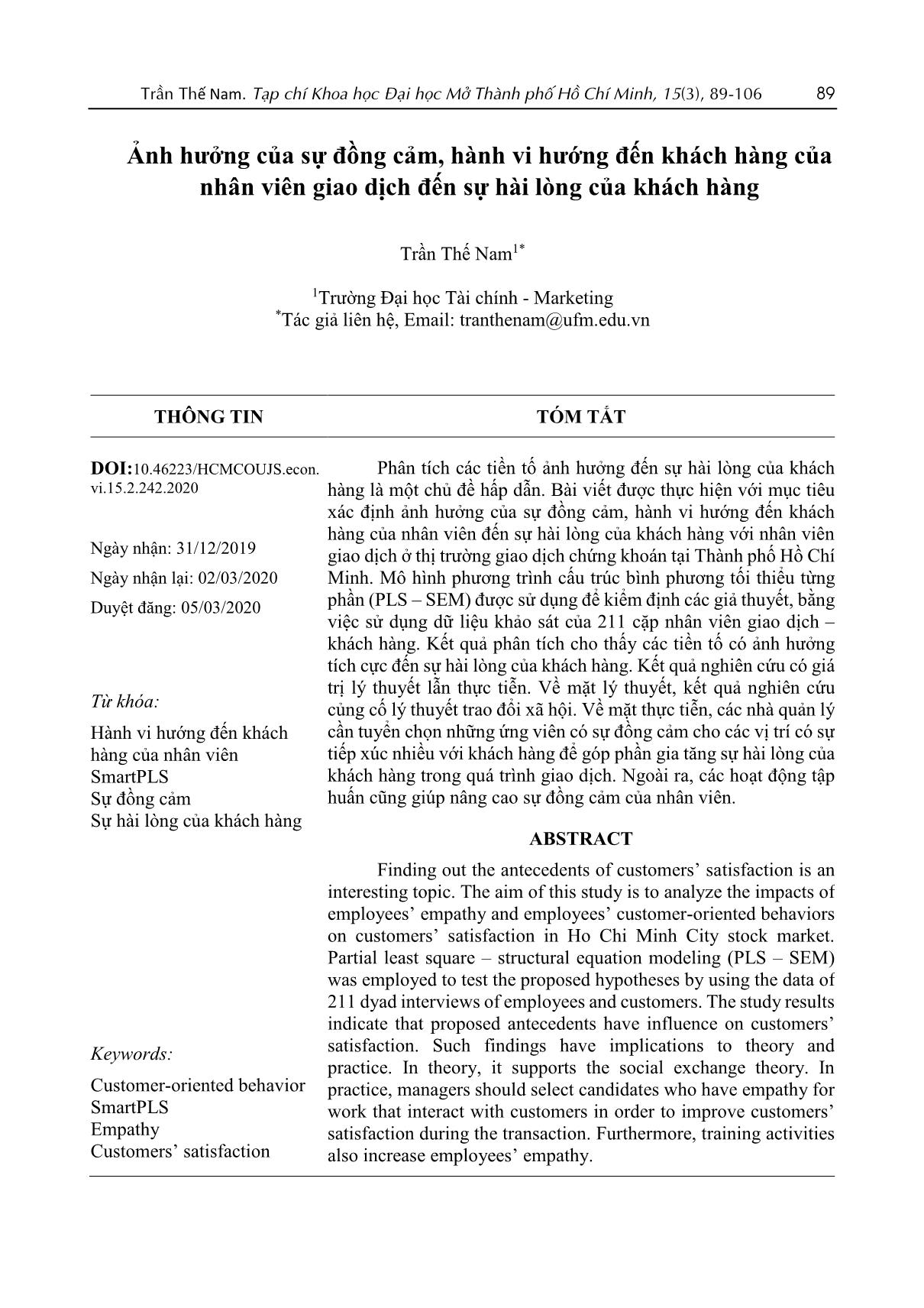
Trang 1
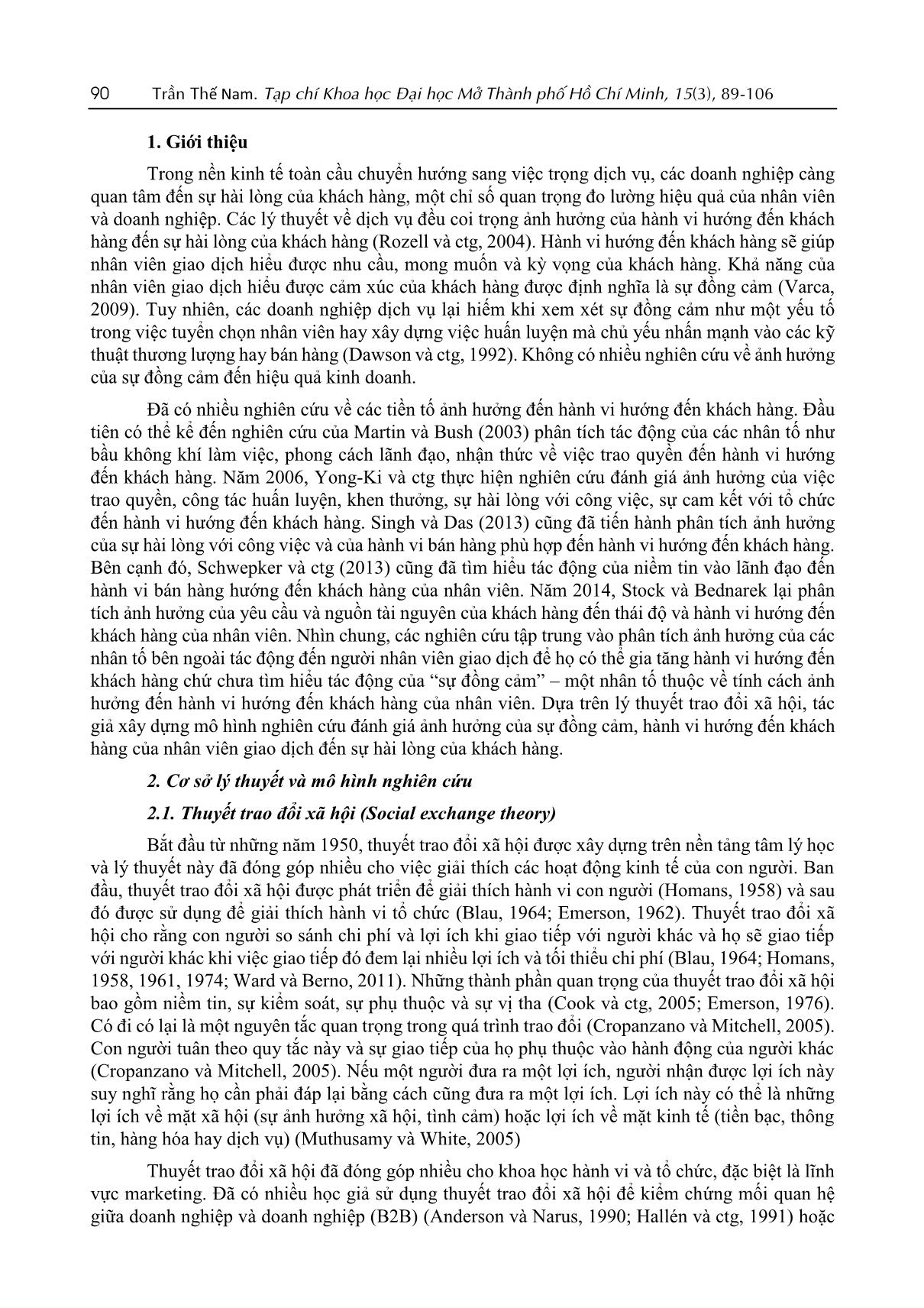
Trang 2
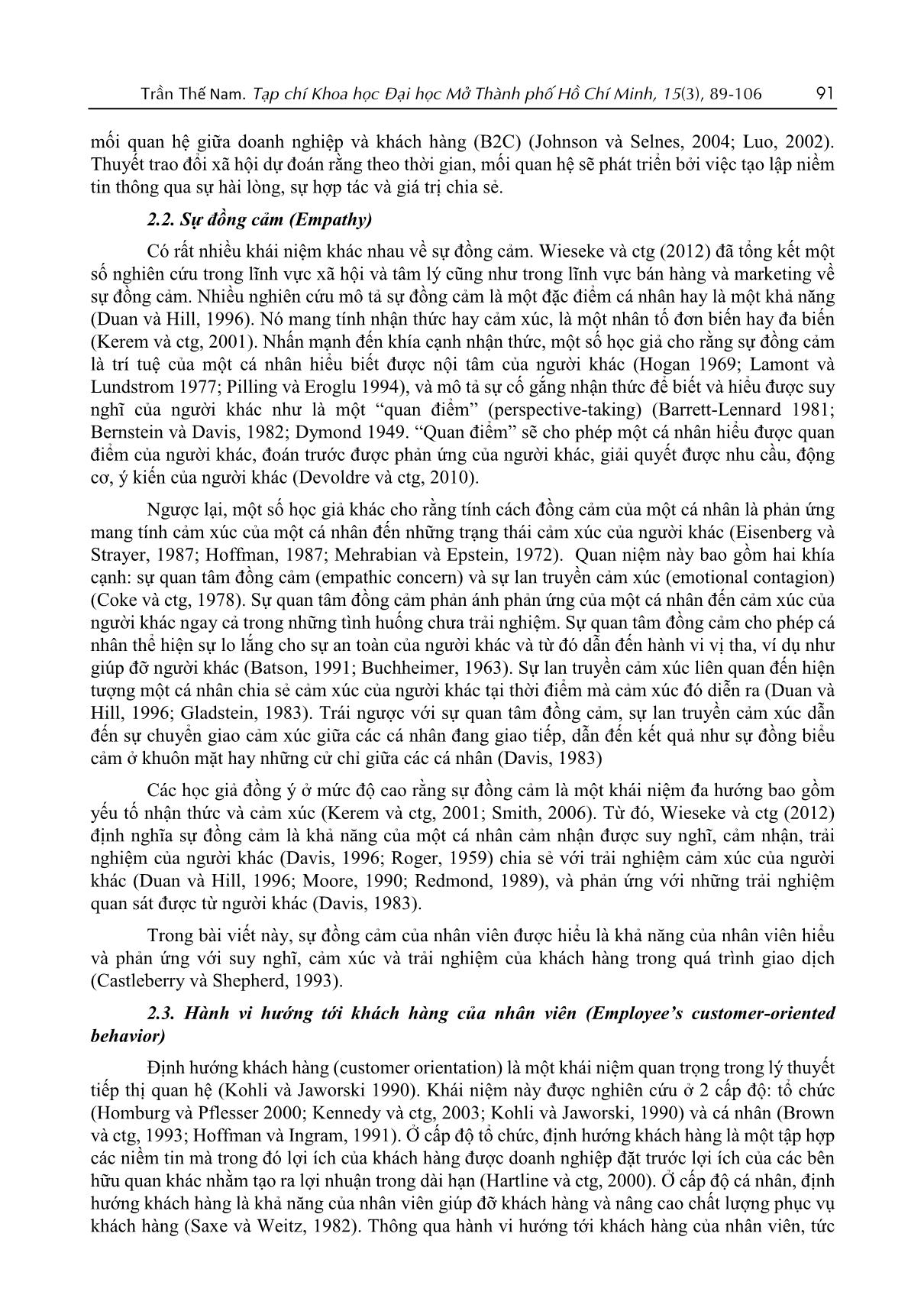
Trang 3

Trang 4
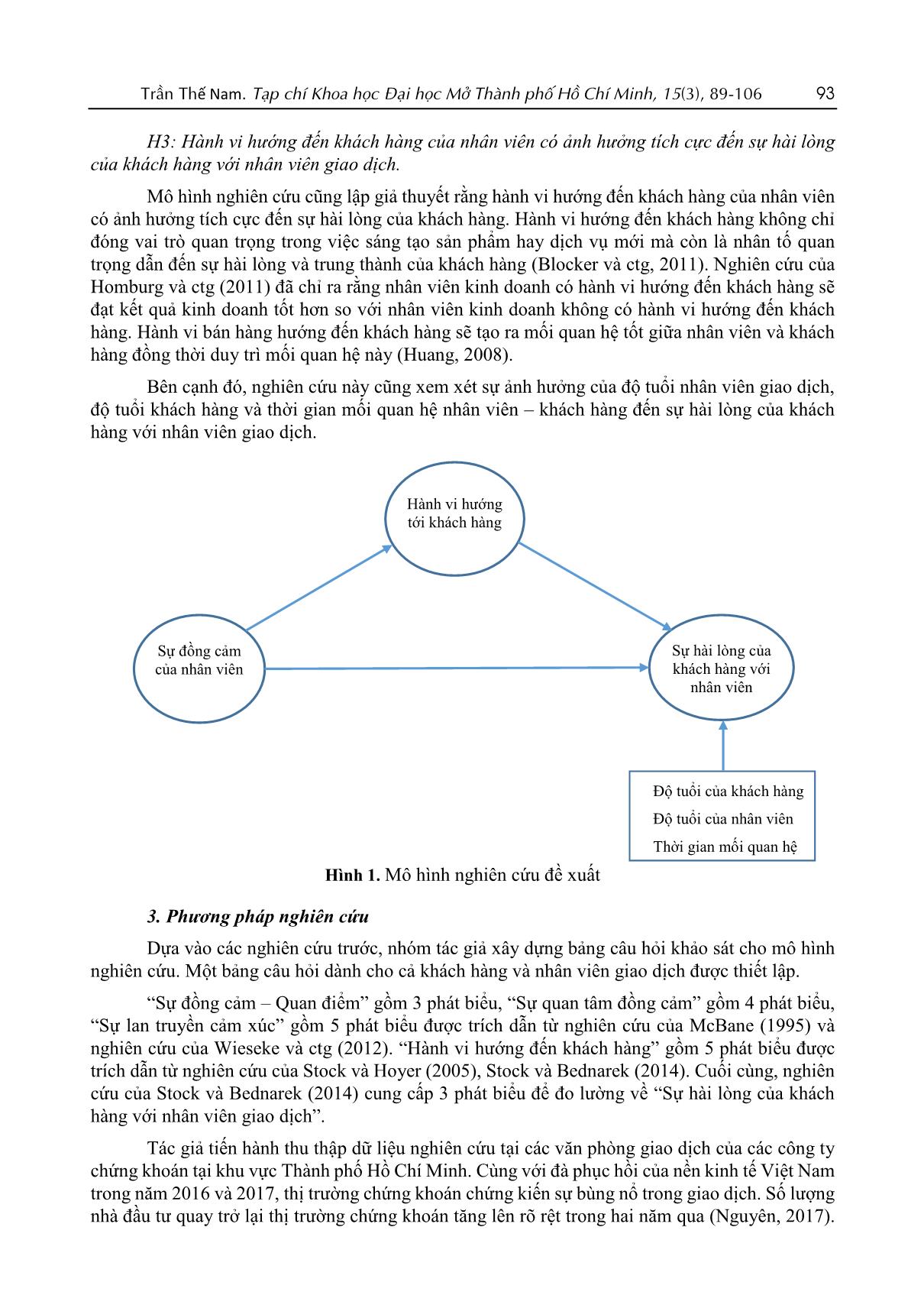
Trang 5
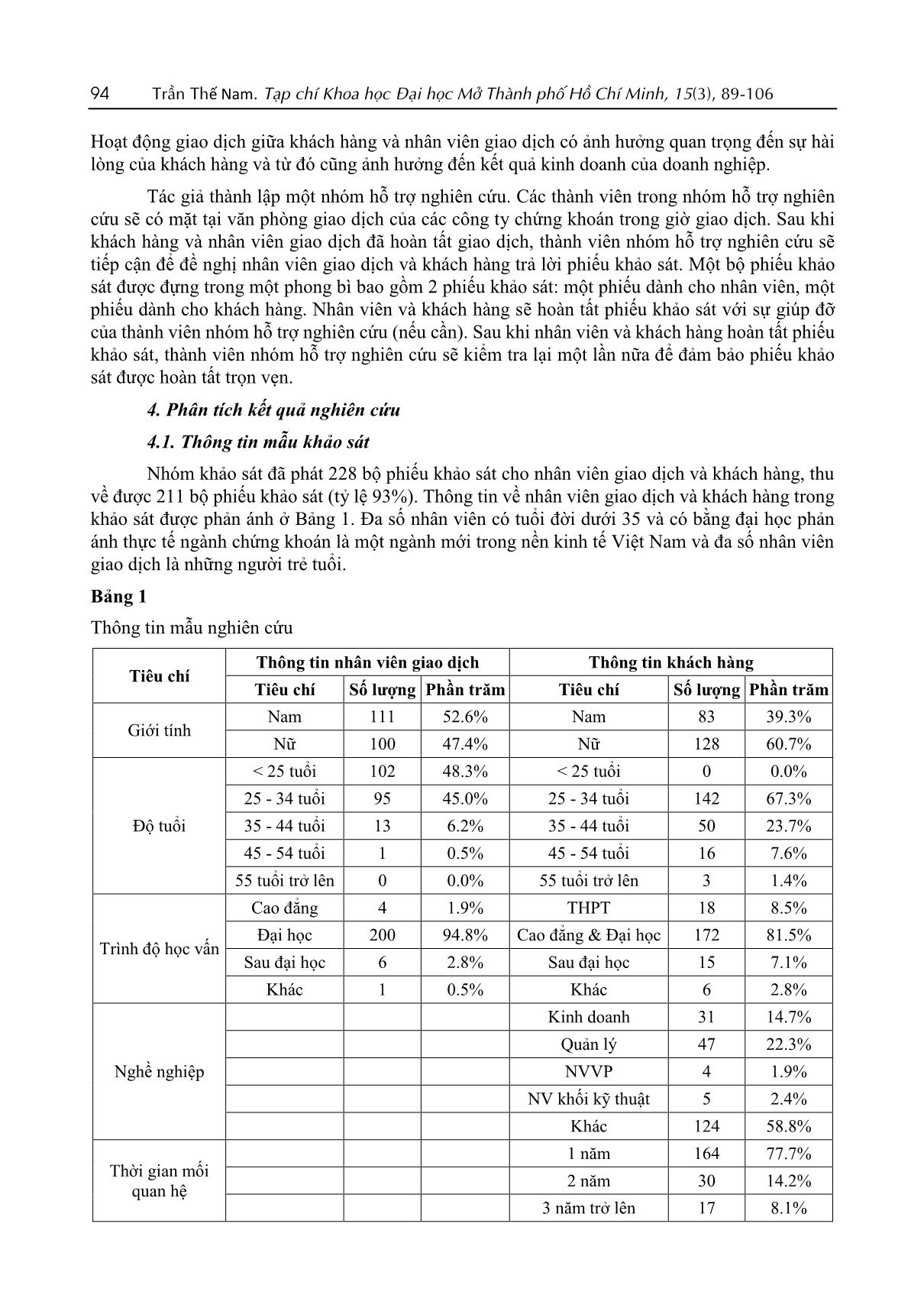
Trang 6
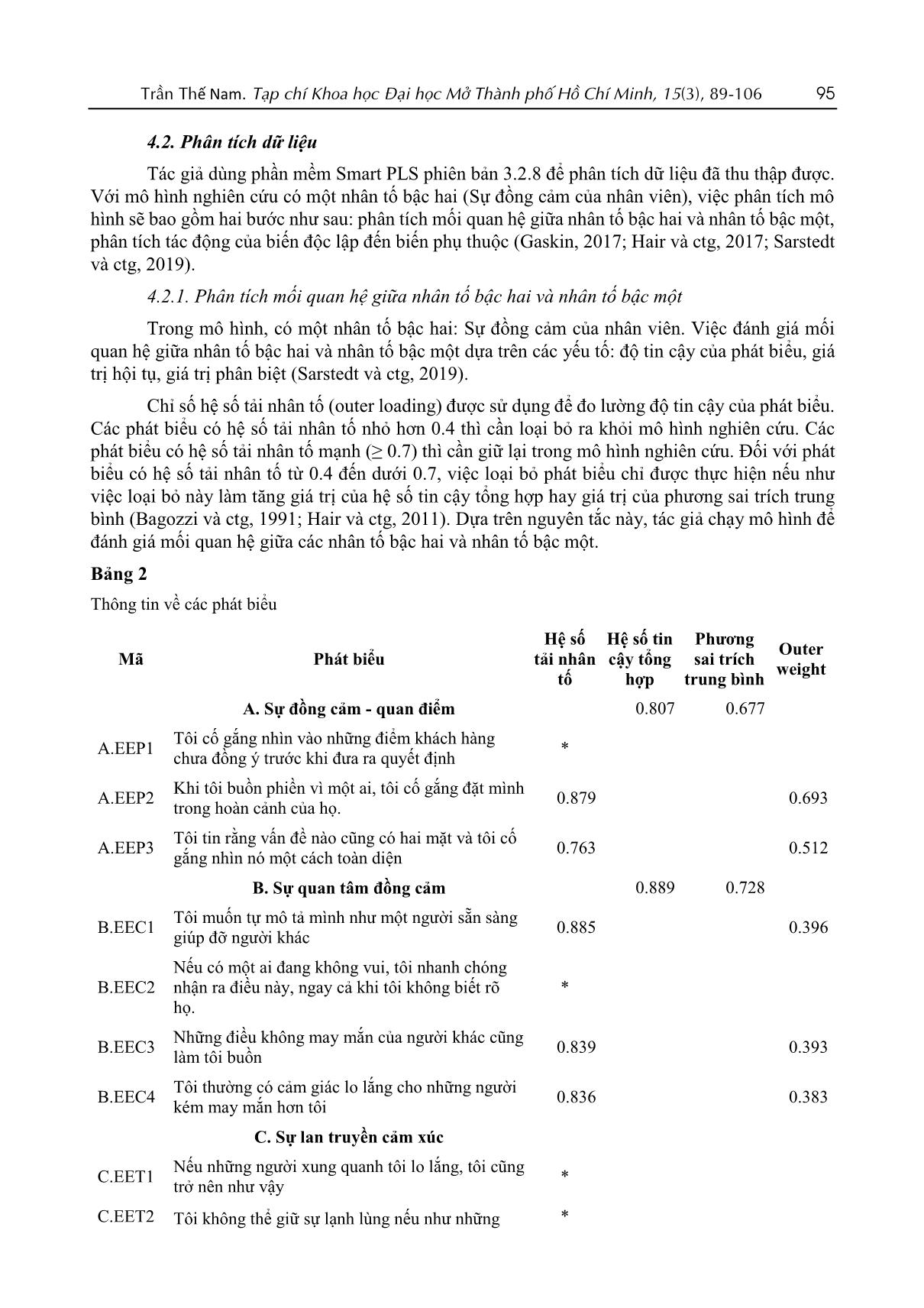
Trang 7
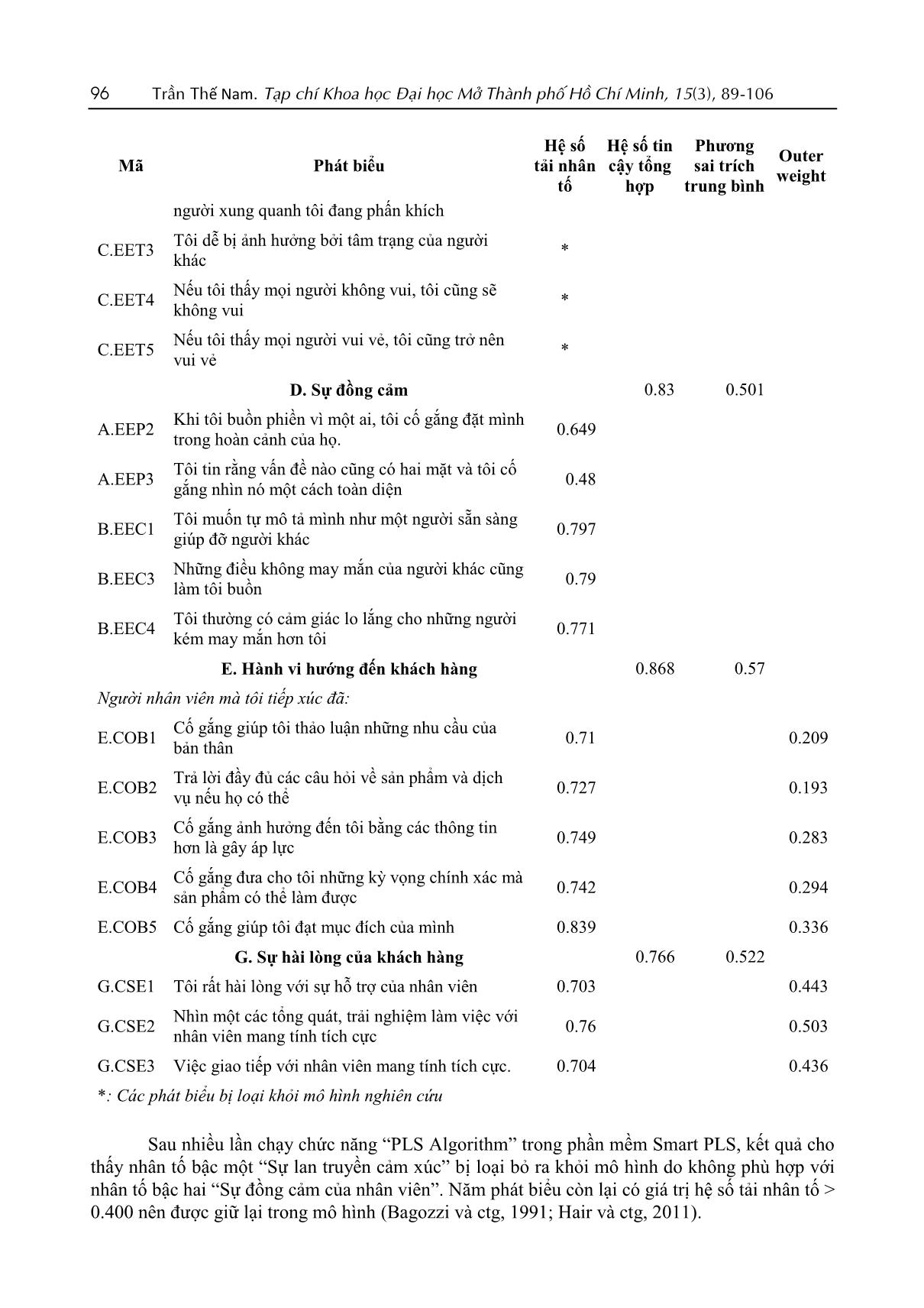
Trang 8
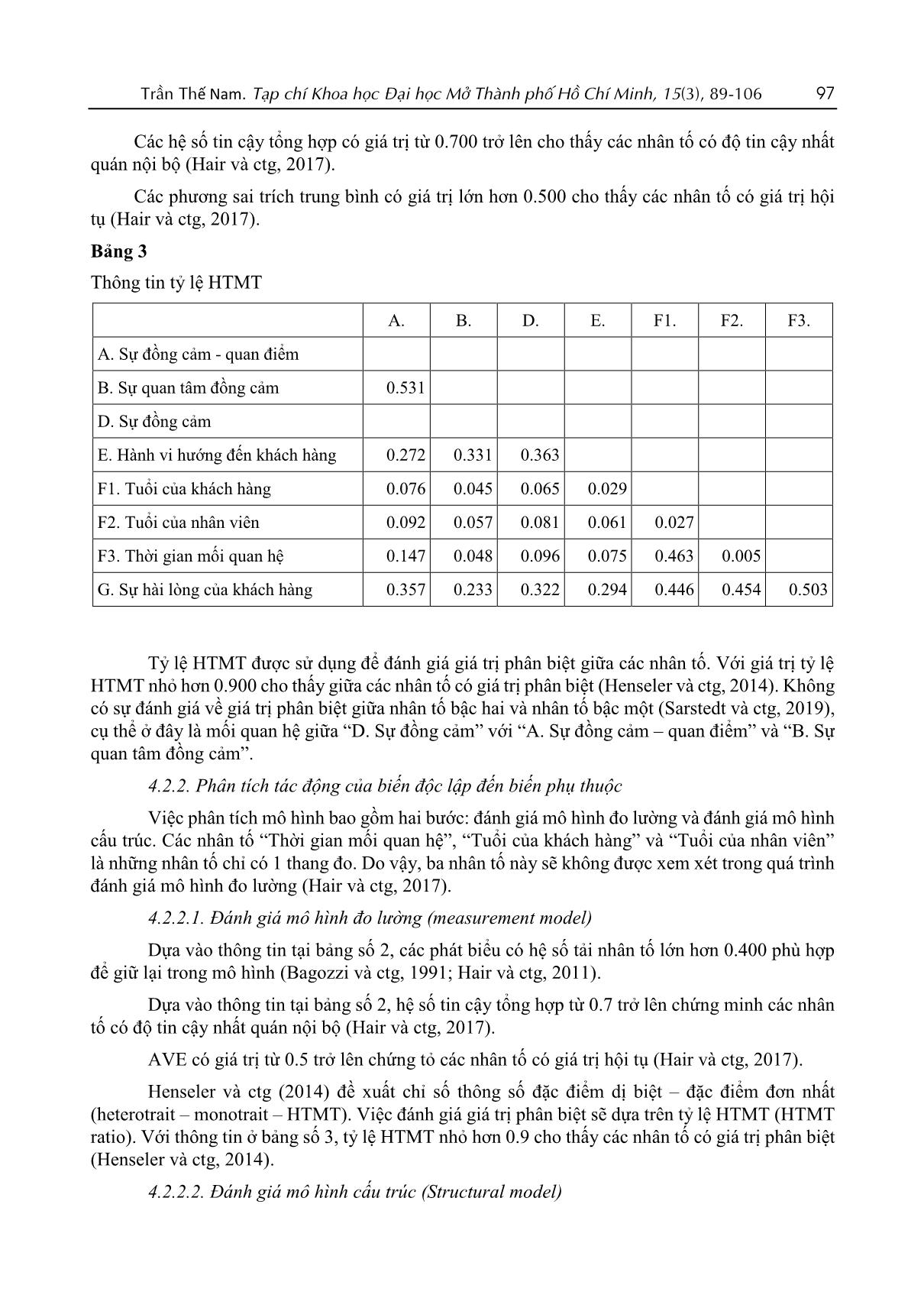
Trang 9
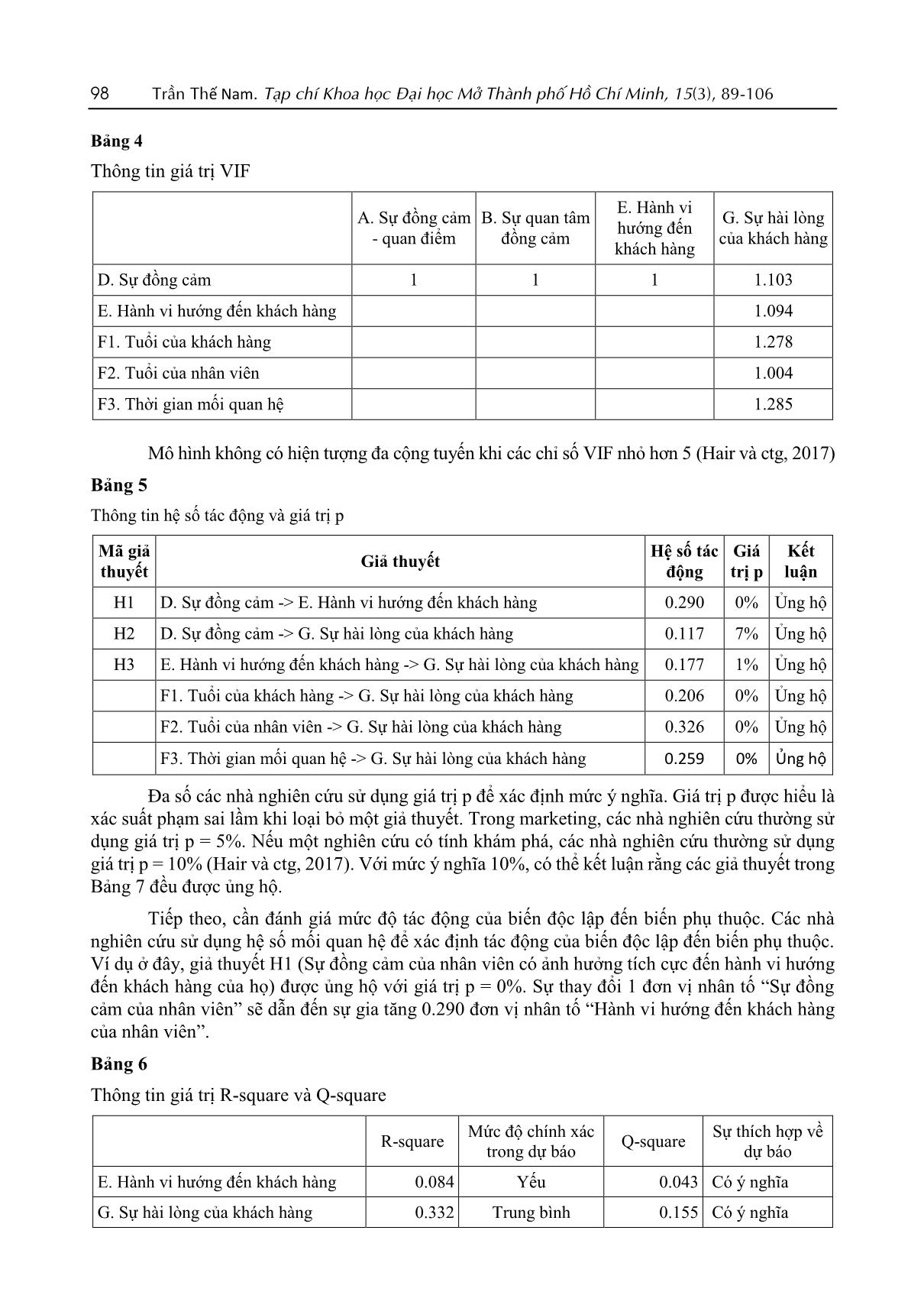
Trang 10
Tải về để xem bản đầy đủ
Tóm tắt nội dung tài liệu: Ảnh hưởng của sự đồng cảm, hành vi hướng đến khách hàng của nhân viên giao dịch đến sự hài lòng của khách hàng
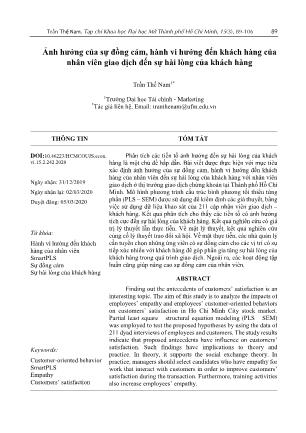
Trần Thế Nam. Tạp chí Khoa học Đại học Mở Thành phố Hồ Chí Minh, 15(3), 89-106 89 Ảnh hưởng của sự đồng cảm, hành vi hướng đến khách hàng của nhân viên giao dịch đến sự hài lòng của khách hàng Trần Thế Nam1* 1Trường Đại học Tài chính - Marketing *Tác giả liên hệ, Email: tranthenam@ufm.edu.vn THÔNG TIN TÓM TẮT DOI:10.46223/HCMCOUJS.econ. vi.15.2.242.2020 Ngày nhận: 31/12/2019 Ngày nhận lại: 02/03/2020 Duyệt đăng: 05/03/2020 Từ khóa: Hành vi hướng đến khách hàng của nhân viên SmartPLS Sự đồng cảm Sự hài lòng của khách hàng Keywords: Customer-oriented behavior SmartPLS Empathy Customers’ satisfaction Phân tích các tiền tố ảnh hưởng đến sự hài lòng của khách hàng là một chủ đề hấp dẫn. Bài viết được thực hiện với mục tiêu xác định ảnh hưởng của sự đồng cảm, hành vi hướng đến khách hàng của nhân viên đến sự hài lòng của khách hàng với nhân viên giao dịch ở thị trường giao dịch chứng khoán tại Thành phố Hồ Chí Minh. Mô hình phương trình cấu trúc bình phương tối thiểu từng phần (PLS – SEM) được sử dụng để kiểm định các giả thuyết, bằng việc sử dụng dữ liệu khảo sát của 211 cặp nhân viên giao dịch – khách hàng. Kết quả phân tích cho thấy các tiền tố có ảnh hưởng tích cực đến sự hài lòng của khách hàng. Kết quả nghiên cứu có giá trị lý thuyết lẫn thực tiễn. Về mặt lý thuyết, kết quả nghiên cứu củng cố lý thuyết trao đổi xã hội. Về mặt thực tiễn, các nhà quản lý cần tuyển chọn những ứng viên có sự đồng cảm cho các vị trí có sự tiếp xúc nhiều với khách hàng để góp phần gia tăng sự hài lòng của khách hàng trong quá trình giao dịch. Ngoài ra, các hoạt động tập huấn cũng giúp nâng cao sự đồng cảm của nhân viên. ABSTRACT Finding out the antecedents of customers’ satisfaction is an interesting topic. The aim of this study is to analyze the impacts of employees’ empathy and employees’ customer-oriented behaviors on customers’ satisfaction in Ho Chi Minh City stock market. Partial least square – structural equation modeling (PLS – SEM) was employed to test the proposed hypotheses by using the data of 211 dyad interviews of employees and customers. The study results indicate that proposed antecedents have influence on customers’ satisfaction. Such findings have implications to theory and practice. In theory, it supports the social exchange theory. In practice, managers should select candidates who have empathy for work that interact with customers in order to improve customers’ satisfaction during the transaction. Furthermore, training activities also increase employees’ empathy. 90 Trần Thế Nam. Tạp chí Khoa học Đại học Mở Thành phố Hồ Chí Minh, 15(3), 89-106 1. Giới thiệu Trong nền kinh tế toàn cầu chuyển hướng sang việc trọng dịch vụ, các doanh nghiệp càng quan tâm đến sự hài lòng của khách hàng, một chỉ số quan trọng đo lường hiệu quả của nhân viên và doanh nghiệp. Các lý thuyết về dịch vụ đều coi trọng ảnh hưởng của hành vi hướng đến khách hàng đến sự hài lòng của khách hàng (Rozell và ctg, 2004). Hành vi hướng đến khách hàng sẽ giúp nhân viên giao dịch hiểu được nhu cầu, mong muốn và kỳ vọng của khách hàng. Khả năng của nhân viên giao dịch hiểu được cảm xúc của khách hàng được định nghĩa là sự đồng cảm (Varca, 2009). Tuy nhiên, các doanh nghiệp dịch vụ lại hiếm khi xem xét sự đồng cảm như một yếu tố trong việc tuyển chọn nhân viên hay xây dựng việc huấn luyện mà chủ yếu nhấn mạnh vào các kỹ thuật thương lượng hay bán hàng (Dawson và ctg, 1992). Không có nhiều nghiên cứu về ảnh hưởng của sự đồng cảm đến hiệu quả kinh doanh. Đã có nhiều nghiên cứu về các tiền tố ảnh hưởng đến hành vi hướng đến khách hàng. Đầu tiên có thể kể đến nghiên cứu của Martin và Bush (2003) phân tích tác động của các nhân tố như bầu không khí làm việc, phong cách lãnh đạo, nhận thức về việc trao quyền đến hành vi hướng đến khách hàng. Năm 2006, Yong-Ki và ctg thực hiện nghiên cứu đánh giá ảnh hưởng của việc trao quyền, công tác huấn luyện, khen thưởng, sự hài lòng với công việc, sự cam kết với tổ chức đến hành vi hướng đến khách hàng. Singh và Das (2013) cũng đã tiến hành phân tích ảnh hưởng của sự hài lòng với công việc và của hành vi bán hàng phù hợp đến hành vi hướng đến khách hàng. Bên cạnh đó, Schwepker và ctg (2013) cũng đã tìm hiểu tác động của niềm tin vào lãnh đạo đến hành vi bán hàng hướng đến khách hàng của nhân viên. Năm 2014, Stock và Bednarek lại phân tích ảnh hưởng của yêu cầu và nguồn tài nguyên của khách hàng đến thái độ và hành vi hướng đến khách hàng của nhân viên. Nhìn chung, các nghiên cứu tập trung vào phân tích ảnh hưởng của các nhân tố bên ngoài tác động đến người nhân viên giao dịch để họ có thể gia tăng hành vi hướng đến khách hàng chứ chưa tìm hiểu tác động của “sự đồng cảm” – một nhân tố thuộc về tính cách ảnh hưởng đến hành vi hướng đến khách hàng của nhân viên. Dựa trên lý thuyết trao đổi xã hội, tác giả xây dựng mô hình nghiên cứu đánh giá ảnh hưởng của sự đồng cảm, hành vi hướng đến khách hàng của nhân viên giao dịch đến sự hài lòng của khách hàng. 2. Cơ sở lý thuyết và mô hình nghiên cứu 2.1. Thuyết trao đổi xã hội (Social exchange theory) Bắt đầu từ những năm 1950, thuyết trao đổi xã hội được xây dựng trên nền tảng tâm lý học và lý thuyết này đã đóng góp nhiều cho việc giải thích các hoạt động kinh tế của con người. Ban đầu, thuyết trao đổi xã hội được phát triển để giải thích hành vi con người (Homans, 1958) và sau đó được sử dụng để giải thích hành vi tổ chức (Blau, 1964; Emerson, 1962). Thuyết trao đổi xã hội cho rằng con người so sánh chi phí và lợi ích khi giao tiếp với người khác và họ sẽ giao tiếp với người khác khi việc giao tiếp đó đem lại nhiều lợi ích và tối thiểu chi phí (Blau, 1964; Homans, 1958, 1961, 1974; Ward và Berno, 2011). Những thành phần quan trọng của thuyết trao đổi xã hội bao gồm niềm tin, sự kiểm soát, sự phụ thuộc và sự vi ... /doi.org/10.2307/2089716 Emerson, R. M. (1976). Social Exchange Theory. Annual Review of Sociology, 2(1), 335-362. https://doi.org/10.1146/annurev.so.02.080176.002003 Trần Thế Nam. Tạp chí Khoa học Đại học Mở Thành phố Hồ Chí Minh, 15(3), 89-106 103 Finn, A., & Kayandé, U. (1999). Unmasking a phantom: a psychometric assessment of mystery shopping22Some work on this paper was carried out while the first author was Visiting Professor, Institute of Marketing, Norwegian School of Economics and Business Administration and the second author was a doctoral candidate at University of Alberta. Order of authorship is alphabetical. Journal of Retailing, 75(2), 195-217. https://doi.org/https://doi.org/10.1016/S0022-4359(99)00004-4 Frazer Winsted, K. (2000). Service behaviors that lead to satisfied customers. European Journal of Marketing, 34(3/4), 399-417. https://doi.org/10.1108/03090560010311920 Frazier, G. L. (1983). Interorganizational Exchange Behavior in Marketing Channels: A Broadened Perspective. Journal of Marketing, 47(4), 68-78. https://doi.org/10.2307/1251400 Gaskin, J. (2017). SmartPLS 3 2nd and 3rd order factors using the repeated indicator approach. Retrieved from https://www.youtube.com/watch?v=LRND-H-hQQw Geisser, S. (1974). A Predictive Approach to the Random Effect Model. Biometrika, 61(1), 101-107. https://doi.org/10.2307/2334290 Giacobbe, R. W., Jackson Jr., D. W., Crosby, L. A., & Bridges, C. M. (2006). A contingency approach to adaptive selling behavior and sales performance: Selling situations and salesperson characteristics. Journal of Personal Selling and Sales Management, 26(2), 115-142. https://doi.org/10.2753/PSS0885-3134260202 Gladstein, G. A. (1983). Understanding empathy: Integrating counseling, developmental, and social psychology perspectives. Journal of Counseling Psychology. US: American Psychological Association. https://doi.org/10.1037/0022-0167.30.4.467 Gwinner, K. P., Bitner, M. J., Brown, S. W., & Kumar, A. (2005). Service customization through employee adaptiveness. Journal of Service Research, 8(2), 131-148. https://doi.org/10.1177/1094670505279699 Hair, J.F., Hult, G.T.M., Ringle, C.M., and Sarstedt, M. (2017). A Primer on Partial Least Squares Structural Equation Modeling (PLS-SEM) (2nd ed.). Thousand Oaks: SAGE Publications. Hair, J. F., Ringle, C. M., & Sarstedt, M. (2011). PLS-SEM: Indeed a Silver Bullet. Journal of Marketing Theory and Practice, 19(2), 139–152. https://doi.org/10.2753/MTP1069-6679190202 Hallén, L., Johanson, J., & Seyed-Mohamed, N. (1991). Interfirm Adaptation in Business Relationships. Journal of Marketing, 55(2), 29–37. https://doi.org/10.2307/1252235 Hartline, M. D., Maxham, J. G., & McKee, D. O. (2000). Corridors of influence in the dissemination of customer-oriented strategy to customer contact service employees. Journal of Marketing, 64(2), 35-50. https://doi.org/10.1509/jmkg.64.2.35.18001 Henseler, J, Ringle, C. M., & Sarstedt, M. (2014). A new criterion for assessing discriminant validity in variance-based structural equation modeling. Journal of the Academy of Marketing Science, 43(1), 115-135. https://doi.org/10.1007/s11747-014-0403-8 Henseler, Jörg, Ringle, C., & R. Sinkovics, R. (2009). The use of partial least squares path modeling in international marketing. In Advances in International Marketing (Vol. 20, pp. 277–319). https://doi.org/10.1108/S1474-7979(2009)0000020014 Hoffman, K. D., & Ingram, T. N. (1991). Creating customer-oriented employees: the case in home health care. Journal of Health Care Marketing, 11(2), 24-32. Hoffman, M. L. (1987). The contribution of empathy to justice and moral judgment. Empathy and Its Development. New York, NY, US: Cambridge University Press. 104 Trần Thế Nam. Tạp chí Khoa học Đại học Mở Thành phố Hồ Chí Minh, 15(3), 89-106 Hogan, R. (1969). Development of an empathy scale. Journal of Consulting and Clinical Psychology. US: American Psychological Association. https://doi.org/10.1037/h0027580 Homans, G. C. (1958). Social Behavior as Exchange. American Journal of Sociology, 63(6), 597-606. https://doi.org/10.1086/222355 Homans, G. C. (1961). Social Behavior: Its Elementary Forms. New York: Harcourt, Brace, and World. Homans, G. C. (1974). Social behavior: Its elementary forms, Revised ed. Social Behavior: Its Elementary Forms, Revised Ed. Oxford, England: Harcourt Brace Jovanovich. Homburg, C, Müller, M., & Klarmann, M. (2011). When should the customer really be king? On the optimum level of salesperson customer orientation in sales encounters. Journal of Marketing, 75(2), 55-74. https://doi.org/10.1509/jmkg.75.2.55 Homburg, C, Wieseke, J., & Bornemann, T. (2009). Implementing the marketing concept at the employee-customer interface: The role of customer need knowledge. Journal of Marketing, 73(4), 64-81. https://doi.org/10.1509/jmkg.73.4.64 Homburg, Christian, & Pflesser, C. (2000). A multiple-layer model of market-oriented organizational culture: Measurement issues and performance outcomes. Journal of Marketing Research, 37(4), 449-462. https://doi.org/10.1509/jmkr.37.4.449.18786 Huang, M.-H. (2008). The influence of selling behaviors on customer relationships in financial services. International Journal of Service Industry Management, 19(4), 458-473. https://doi.org/10.1108/09564230810891905 Johnson, M. D., & Selnes, F. (2004). Customer portfolio management: toward a dynamic theory of exchange relationships. Journal of Marketing, 68(2), 1–17. https://doi.org/10.1509/jmkg.68.2.1.27786 Kennedy, K. N., Goolsby, J. R., & Arnould, E. J. (2003). Implementing a customer orientation: extension of theory and application. Journal of Marketing, 67(4), 67-81. https://doi.org/10.1509/jmkg.67.4.67.18682 Kerem, E., Fishman, N., & Josselson, R. (2001). The experience of empathy in everyday relationships: Cognitive and affective elements. Journal of Social and Personal Relationships, 18(5), 709-729. https://doi.org/10.1177/0265407501185008 Kohli, A. K., & Jaworski, B. J. (1990). Market orientation: The construct, research propositions, and managerial implications. Journal of Marketing. US: American Marketing Association. https://doi.org/10.2307/1251866 Konovsky, M. A., & Pugh, S. D. (1994). Citizenship behavior and social exchange. Academy of Management Journal. US: Academy of Management. https://doi.org/10.2307/256704 Kotler, P. (2001). Marketing Management. Pearson Education Canada. Retrieved from https://books.google.com.vn/books?id=MR15PwAACAAJ Lamont, L. M., & Lundstrom, W. J. (1977). Identifying successful industrial salesmen by personality and personal characteristics. Journal of Marketing Research. US: American Marketing Association. https://doi.org/10.2307/3151192 Luo, X. (2002). Trust production and privacy concerns on the Internet: A framework based on relationship marketing and social exchange theory. Industrial Marketing Management, 31(2), 111-118. https://doi.org/https://doi.org/10.1016/S0019-8501(01)00182-1 Martin, C. A., & Bush, A. J. (2003). The potential influence of organizational and personal variables on customer-oriented selling. The Journal of Business & Industrial Marketing, Trần Thế Nam. Tạp chí Khoa học Đại học Mở Thành phố Hồ Chí Minh, 15(3), 89-106 105 18(2/3), 114-30. Retrieved from https://search.proquest.com/docview/222024066? accountid=47774 McBane, D. A. (1995). Empathy and the salesperson: A multidimensional perspective. Psychology & Marketing, 12(4), 349-370. https://doi.org/10.1002/mar.4220120409 Mehrabian, A., & Epstein, N. (1972). A measure of emotional empathy. Journal of Personality. United Kingdom: Blackwell Publishing. https://doi.org/10.1111/j.1467-6494.1972.tb00078.x Moore, B. S. (1990). The origins and development of empathy. Motivation and Emotion. Germany: Springer. https://doi.org/10.1007/BF00991636 Muthusamy, S. K., & White, M. A. (2005). Learning and knowledge transfer in strategic alliances: A social exchange view. Organization Studies, 26(3), 415-441. https://doi.org/10.1177/ 0170840605050874 Nguyên, H. (2017). TTCK phục hồi kỷ lục: Chuyển biến về chất. Retrieved from Oliver, R. L. (1999). Whence Consumer Loyalty? Journal of Marketing, 63, 33-44. https://doi.org/10.2307/1252099 Parker, S. K., & Axtell, C. M. (2001). Seeing another viewpoint: Antecedents and outcomes of employee perspective taking. Academy of Management Journal, 44(6), 1085-1100. https://doi.org/10.2307/3069390 Peterson, R. T., & Limbu, Y. (2009). The convergence of mirroring and empathy: Communications training in business-to-business personal selling persuasion efforts. Journal of Business-to- Business Marketing, 16(3), 193-219. https://doi.org/10.1080/10517120802484551 Pettijohn, C. E., Pettijohn, L. S., Keillor, B. D., & Taylor, A. J. (2011). (2000). Adaptive Selling And Sales Performance: An Empirical Examination. Journal of Applied Business Research (JABR), 16(1). https://doi.org/https://doi.org/10.19030/jabr.v16i1.2031 Pilling, B. K., & Eroglu, S. (1994). An empirical examination of the impact of salesperson empathy and professionalism and merchandise salability on retail buyers’ evaluations. Journal of Personal Selling and Sales Management, 14(1), 45-58. https://doi.org/10.1080/08853134. 1994.10753975 Redmond, M. V. (1989). The functions of empathy (decentering) in human relations. Human Relations, 42(7), 593-605. https://doi.org/10.1177/001872678904200703 Roger Chapman Thorne. (1959). Journal of Christian Education, os-2(1), 2. https://doi.org/10.1177/002196575900200101 Rozell, E. J., Pettijohn, C. E., & Parker, R. S. (2004). Customer-oriented selling: Exploring the roles of emotional intelligence and organizational commitment. Psychology & Marketing, 21(6), 405-424. https://doi.org/10.1002/mar.20011 Sarstedt, M., Hair, J. F., Cheah, J.-H., Becker, J.-M., & Ringle, C. M. (2019). How to specify, estimate, and validate higher-order constructs in PLS-SEM. Australasian Marketing Journal (AMJ). https://doi.org/https://doi.org/10.1016/j.ausmj.2019.05.003 Saxe, R., & Weitz, B. A. (1982). The SOCO Scale: A measure of the customer orientation of salespeople. Journal of Marketing Research, 19(3), 343-351. https://doi.org/10.2307/3151568 Schneider, B., & Schechter, D. (1991). Development of a personnel selection system for service jobs. In S. W. Brown, E. Gummesson, B. Edvardson, & B. Gustavsson (Eds.), 106 Trần Thế Nam. Tạp chí Khoa học Đại học Mở Thành phố Hồ Chí Minh, 15(3), 89-106 Service Quality. Multidisciplinary and Multinational Perspectives (pp. 217-236). New York: Lexington Books. Schwepker Jr, C. H., & Schultz, R. J. (2013). The impact of trust in manager on unethical intention and customer-oriented selling. The Journal of Business & Industrial Marketing, 28(4), 347-356. https://doi.org/ Singh, R., & Das, G. (2013). The impact of job satisfaction, adaptive selling behaviors and customer orientation on salesperson’s performance: exploring the moderating role of selling experience. The Journal of Business & Industrial Marketing, 28(7), 554-564. https://doi.org/ Smith, A. (2006). Cognitive empathy and emotional empathy in human behavior and evolution. The Psychological Record. Smith, Adam: Dryburgh Industrial Estate, 7 Faraday Street, Dundee, Scotland, DD2 3QQ, adamjamessmith@fsmail.net: Kenyon Coll Psychology Dept. Stock, R.M. & Bednarek, M. (2014). As they sow, so shall they reap: customers’ influence on customer satisfaction at the customer interface. Journal of Academy Marketing Science, 42(4), 400-414. https://doi.org/https://doi.org/10.1007/s11747-013-0355-4 Stock, Ruth M, & Bednarek, M. (2014). As they sow, so shall they reap: customers’ influence on customer satisfaction at the customer interface. Journal of the Academy of Marketing Science, 42(4), 400-414. https://doi.org/10.1007/s11747-013-0355-4 Stock, Ruth Maria, & Hoyer, W. D. (2002). Leadership style as driver of salespeoples’ customer orientation. Journal of Market - Focused Management, 5(4), 355-376. Retrieved from https://search.proquest.com/docview/200855472?accountid=47774 Stock, Ruth Maria, & Hoyer, W. D. (2005). An attitude-behavior model of salespeople’s customer orientation. Journal of the Academy of Marketing Science, 33(4), 536-552. Retrieved from https://search.proquest.com/docview/224887282?accountid=47774 Stone, M. (1974). Cross-validatory choice and assessment of statistical predictions. Journal of the Royal Statistical Society. Series B (Methodological), 36(2), 111-147. Retrieved from Storbacka, K., Strandvik, T., & Gronroos, C. (1994). Managing customer relationships for profit: the dynamics of relationship quality. International Journal of Service Industry Management, 5(5), 21-38. https://doi.org/10.1108/09564239410074358 Varca, P. E. (2009). Emotional empathy and front line employees: does it make sense to care about the customer? Journal of Services Marketing, 23(1), 51-56. https://doi.org/10.1108/0887604 0910933093 Ward, C., & Berno, T. (2011). Beyond social exchange theory: Attitudes toward tourists. Annals of Tourism Research, 38(4), 1556-1569. https://doi.org/https://doi.org/10.1016/j.annals. 2011.02.005 Wieseke, J., Geigenmüller, A., & Kraus, F. (2012). On the role of empathy in customer-employee interactions. Journal of Service Research, 15(3), 316–331. https://doi.org/10.1177/1094670512439743 Yong-Ki, L., Jung-Heon, N., Park, D.-H., & Lee, K. A. (2006). What factors influence customer- oriented prosocial behavior of customer-contact employees? The Journal of Services Marketing, 20(4), 251-264. https://doi.org/ Zineldin, M. (2000). Total relationship management (TRM) and total quality management (TQM). Managerial Auditing Journal, 15, 20-28. https://doi.org/10.1108/02686900010304399
File đính kèm:
 anh_huong_cua_su_dong_cam_hanh_vi_huong_den_khach_hang_cua_n.pdf
anh_huong_cua_su_dong_cam_hanh_vi_huong_den_khach_hang_cua_n.pdf

